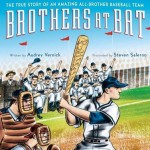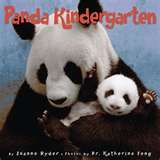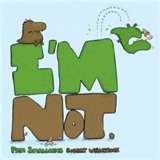“Brothers at Bat” is Notable!
 After a solid month of all the members of my household taking turns being sick (seriously, we dubbed our home “Contagion Manor”), I was so glad to return to work and see some of my favorite books on the New York Times Notable Children’s Books of 2012 list. I cheered when I saw on the Picture Book list a title by one of my author-friends, Audrey Vernick (remember her fantastic book Is Your Buffalo Ready for Kindergarten? I know, I loved it, too!) And then I realized that Brothers at Bat is the only non-fiction picture book on the list. I read lots of picture books to kids, and I’m trying to work at least one informational book into each reading. The best way to improve reading comprehension of information is to immerse our kids in interesting informational books. So if you’re on the lookout for fantastic non-fiction, here’s the most Notable of the 2012 bunch!
After a solid month of all the members of my household taking turns being sick (seriously, we dubbed our home “Contagion Manor”), I was so glad to return to work and see some of my favorite books on the New York Times Notable Children’s Books of 2012 list. I cheered when I saw on the Picture Book list a title by one of my author-friends, Audrey Vernick (remember her fantastic book Is Your Buffalo Ready for Kindergarten? I know, I loved it, too!) And then I realized that Brothers at Bat is the only non-fiction picture book on the list. I read lots of picture books to kids, and I’m trying to work at least one informational book into each reading. The best way to improve reading comprehension of information is to immerse our kids in interesting informational books. So if you’re on the lookout for fantastic non-fiction, here’s the most Notable of the 2012 bunch!
Brothers at Bat: the true story of an amazing all-brother baseball team is written by Audrey Vernick and illustrated by Steven Salerno. In 1938, the twelve Acerra brothers formed their own semi-pro baseball team. With their dad as their coach, the brothers went on to win league championships four times, and earned a place in the Baseball Hall of Fame as the longest-playing all-brother baseball team. Salerno’s art perfectly captures the feel of the 1930s and 1940s. I love the photo at the end of the book showing all the brothers in uniform.
More than just a book about an interesting bit of baseball trivia, the heart of this story is how the brothers were a team for life, both on and off the field. “As the younger brothers grew up,” Vernick writes, “the older ones shared playing time.” When Alfred loses an eye due to a bad bounce of a baseball, his brothers work with him so he can rejoin the team. “He was a pretty good catcher for a guy with one eye,” one brother says. You can discuss with your students all the examples of teamwork in this book to hit the Common Core State Standard of Key Ideas and Details. Talk about teamwork in your classroom. Your students can each make a “baseball” card for themselves, and even team uniforms with white t-shirts and Sharpie markers! Take your students outside for a game of catch with the little bouncy balls from the dollar store. You’ll build hand-eye coordination, cooperation skills, and a sense of teamwork in your classroom. Play ball!
Audrey Vernick has a curriculum guide with lots of discussion questions and ideas on her website: audreyvernick.com. On Steven Salerno’s website you can see some of the illustrations for this book in process: stevensalerno.com.
Read More
Bones: Skeletons and How They Work
I could say, “here’s an informational book that will tickle your funny bone” or “it’s so good it’s scary”, but Bones: Skeletons and How They Work by Steve Jenkins needs no rib-tickling tricks to get kids’ attention. For Halloween or health units, this book is thoroughly engaging. Using cut paper, Jenkins makes incredible illustrations of all kinds of bones to show how structure aids function. Some of the bones are shown actual size, so it’s easy to compare a human skull to that of a baboon, a dog, a parrot, or an armadillo. Some bones are too large to show in actual size, so Jenkins makes the bones to scale. Kids can compare an adult human’s foot bones to the fossil foot bones of a Tyrannosaurus rex! Not only is this book visually a treat, it’s chock-full of “who knew?” facts that kids love: “a giraffe’s neck is as long as a man is tall, but giraffes and humans have the same number of neck bones: seven.”
I love sharing informational books like this with students. With Steve Jenkins’ books, I’m squeezing in the Common Core State Standards of Range of Reading and Key Ideas and Details, I can work interesting books into math and science units, I’m immersing my students in nonfiction, and all the while the kids think they’re just enjoying a good book. Because most of Jenkins’ illustrations are actual size or to scale, you can use Bones: Skeletons and How They Work in a measurement lesson. Kids can estimate how long a bone is and measure it with a ruler. For higher level math, have students measure the to-scale illustrations and multiply to get actual-size measurements.
If you read this book with students around Halloween, it can be a springboard to make some spooky decorations. At enchantedlearning.com, you can print off a human skeleton template for students to cut out and put together with brads to see how all our bones fit. Hang up the skeletons and your decorations are not only scary, they are scientific! For a treat that’s not loaded with sugar, try serving “Bones Dipped in Blood” (pull breadstick dough into bone shapes, bake, and serve with pizza sauce.) To incorporate a bit of technology and to rock it old school, go to YouTube and treat your students to the Schoolhouse Rock video clip of “Them Not-So-Dry Bones”. “Right now there’s a skeleton locked up inside of you!”
For more information, please visit Steve Jenkins’ website: stevejenkinsbooks.com.
Read MorePanda Kindergarten
 It’s back-to-school time, even for pandas. Joanne Ryder and Dr. Katherine Feng have made the world’s cutest informational book, Panda Kindergarten. The photos of the baby pandas at the Wolong Nature Reserve in China are unbearably adorable. Sixteen roly-poly panda cubs are learning the skills they will need to survive in the wild some day. No math or phonics lessons in this kindergarten class, but lots of social skills are learned as the pandas climb on the wooden structures, tumble in the snow, and even take afternoon naps together.
It’s back-to-school time, even for pandas. Joanne Ryder and Dr. Katherine Feng have made the world’s cutest informational book, Panda Kindergarten. The photos of the baby pandas at the Wolong Nature Reserve in China are unbearably adorable. Sixteen roly-poly panda cubs are learning the skills they will need to survive in the wild some day. No math or phonics lessons in this kindergarten class, but lots of social skills are learned as the pandas climb on the wooden structures, tumble in the snow, and even take afternoon naps together.
One of the Common Core State Standards in reading across all grade levels is “range of reading”. More and more, our students will be expected to read informational text and “show what they know”. One of the best ways you can help students become more fluent informational readers is to surround them with irresistible nonfiction books. Panda Kindergarten is a picture book with simple text and great photos, so it works as well for a read-aloud as any story picture book. After reading this book aloud, and pausing for the inevitable “Awwwww!’ with each photo, read the “fast facts” on the last page. “A newborn giant panda is the size of a stick of butter and weighs about four ounces…. an adult panda can weigh well over 200 pounds.” How much is four ounces? How much is a pound? Make a list of weight predictions: “I think a stapler weighs four ounces.” Bring scales into your classroom. Let students weigh and record a variety of objects to find out what else is about four ounces to get a sense of how small a newborn panda is. Students can also weigh themselves on a scale. How many students would it take to weigh about as much as an adult giant panda?
Students can also compare “panda kindergarten” and kindergarten for humans using a Venn diagram, or by writing and drawing things that are the same and things that are different. Go outside to see if your students can “swing and climb and play with their (new) friends” like panda cubs do!
To find out more about the China Conservation and Research Center for the Giant Panda at the Wolong Nature Preserve, please visit pandasinternational.org.
Read MoreI’m Not
 Being friends with really cool people can sometimes lead me down the “compare and despair” spiral of gloom. My husband is an artist. I’m not. One of my friends is a belly dancer. I’m not. Another friend is an organic gardener. I grow weeds. *sigh* So when I saw Pam Smallcomb’s book I’m Not with its adorable illustrations by Robert Weinstock, I knew I’d found the picture book for me. The main character (a crocodile? An alligator? A dinosaur with a little pink bow on her head?) is a bit jealous of her friend, Evelyn. “She’s not one single bit ordinary. And she’s a little mysterious. I’m not.” Evelyn is stylish, talented, energetic, and creative. (Most of my friends are Evelyns.) The croco-gator-dinosaur is not. But she makes yummy cookies, isn’t afraid of the dark, and is a good speller. Evelyn isn’t. And Evelyn needs “a true-blue friend”, which our main character most certainly is.
Being friends with really cool people can sometimes lead me down the “compare and despair” spiral of gloom. My husband is an artist. I’m not. One of my friends is a belly dancer. I’m not. Another friend is an organic gardener. I grow weeds. *sigh* So when I saw Pam Smallcomb’s book I’m Not with its adorable illustrations by Robert Weinstock, I knew I’d found the picture book for me. The main character (a crocodile? An alligator? A dinosaur with a little pink bow on her head?) is a bit jealous of her friend, Evelyn. “She’s not one single bit ordinary. And she’s a little mysterious. I’m not.” Evelyn is stylish, talented, energetic, and creative. (Most of my friends are Evelyns.) The croco-gator-dinosaur is not. But she makes yummy cookies, isn’t afraid of the dark, and is a good speller. Evelyn isn’t. And Evelyn needs “a true-blue friend”, which our main character most certainly is.
After reading I’m Not, put signs in three corners of your classroom: “I’m not”, “I am” and “I am, sometimes”. Start with a statement inspired by Smallcomb’s book: “If I were a car, I would get a speeding ticket.” Let students sort themselves into one of the three areas. Give more statements for students to sort themselves. You can turn these statements into the ice-breaker game of “Buddy Bingo” for a Self-Smart reading activity. Write the statements in squares on sheets of paper like a Bingo card. (To keep an upbeat vibe going, I’d choose all positive statements!) Tape a sheet to each student’s back, or give each student the sheet on a clipboard. Students can write their names in squares they feel describe them, but they should write only once on any sheet. See if your students can find enough different classmates to fill the squares, and let them choose one to fill in on their own page. Rather than focus on what we are not, encourage your students to focus on all that we are. I am!
For more information, please check out Pam Smallcomb’s site: pamsmallcomb.com and Robert Weinstock’s website: callmebob.com.
Read More







